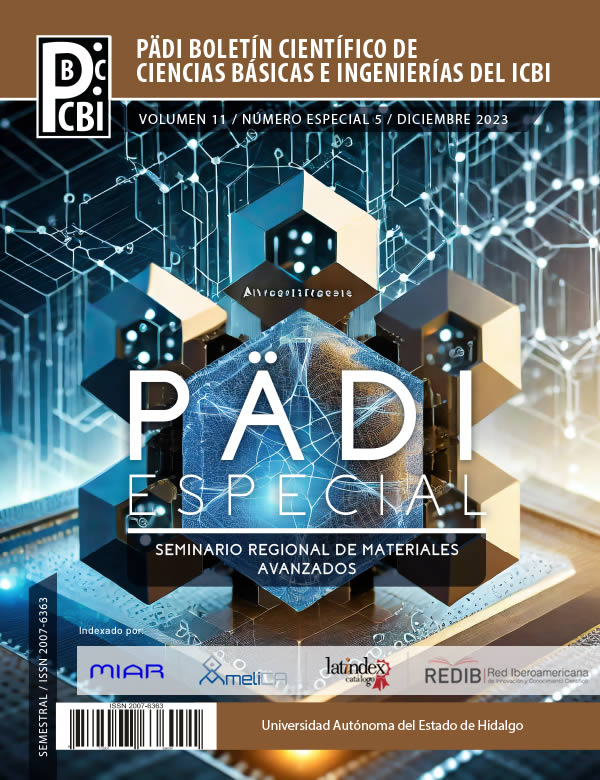Effect of the austempering temperature in CADIs alloyed with Chromium
DOI:
https://doi.org/10.29057/icbi.v11iEspecial5.11809Keywords:
CADI, austempering, window process, microstructure, ausferriteAbstract
The ductile irons with carbides inside of metallic matrix that were heat treated through austempering are called CADIs. These materials present high mechanical properties such as hardness and wear resistance. In this work, CADIs alloyed with 0.2 %Cr were obtained using austempering temperatures of 265 and 305 °C together with austempering times of 30, 60, 90 and 120 min. The microstructural characterization was carried out employing the light microscopy and scanning electron microscope, the quantitative analysis with Image software, while mechanical characterization using hardness and wear resistance. The results showed that the ausferritic matrix was obtained at 90 min of austempering heat treatment, while the window process in the temperatures range from 60 to 120 min. The highest volume fraction of high carbon austenite (14.45 %) was obtained in CADI-305. The highest Rockwell C Hardness of 41 HRC and wear resistance of 0.42 mm3 were obtained with CADI-265.
Downloads
Publication Facts
Reviewer profiles N/A
Author statements
Indexed in
- Academic society
- N/A
References
Becerra-Mayorga C.Y., Vargas-Ramírez M., Cruz-Ramírez A., García-Serrano J. Colin-García E., (2022). Ventana óptima de hierro dúctil austemperizado con aleantes carburizadores. Pädi Boletín Científico De Ciencias Básicas E Ingeniería Del ICBI, 10 (especial 7), 118-124. DOI: 10.29057/icbi.v10iEspecial7.9823
Bedolla-Jacuinde, A., Hernandez-Hernandez, R. A., Vapeani Guerra F., Mejia I., (2020). The role of chromium during austempering of ductile iron. Metallurgical Research & Technology 117, 2020. DOI: 10.1051/metal/2019072
Gawhare S., Harne M., Patil S., (2015). Effect of chemical composition and austempering temperature on properties of CADI. International Journal of Advanced Technology in Engineering and Science 3, 184–193.
Han Ch. F., Sun Y. F., Wu Y., Ma Y. H., (2015). Effects of Vanadium and Austempering Temperature on Microstructure and Properties of CADI. Metallography, Microstructure, and Analysis 4, 135–145. DOI: 10.1007/s13632-015-0197-1
Hayrynen K. L., (2002). The Production of Austempered Ductile Iron (ADI). World conference on ADI, 1-6.
Hayrynen K. L., K. R. Brandenberg, (2003). Carbidic Austempered Ductile Iron (CADI) - The New Wear Material. Transactions of American Foundry Society 111, 1–6.
Kristin R. B., Hayrynen K. L., (2002). Agricultural applications of austempered ductile iron. World conference on ADI, 135-142.
Kyeong-hwan C., Kyoung-mook L., Snag-mok L., Kyong-whoan L. (2011.) The effect of vanadium and chromium on the precipitation of carbide in Si-Mo ferritic ductile cast iron. Key Engineering Materials 457, 102-107. DOI: 10.4028/www.scientific.net/KEM.457.102
Laino S., Sikora J. A., Dommarco R. C., (2008). Development of wear resistant carbidic austempered ductile iron (CADI). Wear 265, 1–7. DOI: 10.1016/j.wear.2007.08.013
Laino S., Sikora J. A., Dommarco R. C., (2009). Influence of chemical composition and solidification rate on the abrasion and impact properties of CADI,” ISIJ International 49, 1239–1245. DOI: 10.2355/isijinternational.49.1239
Mahadik S. P., Harne M. S., Raka V. B., (2017). Study on the Effect of Austempering Temperature and Time on the Corrosion Resistance of Carbidic Austempered Ductile Iron (CADI) Material. Journal of Advances in Science and Technology 13, 234-240.
Miller R. L., (1964). A rapid method for the determination of retained austenite. Trans ASM 57, 892-899.
Neri M.A., Carreño C., (2003). Effect of copper content on the microstructure and mechanical properties of a modified nodular iron. Materials Characterization 51, 219-224. DOI: 10.1016/j.matchar.2003.09.001
Parhad P., Umale S., Likhite A., Bhatt J., (2012). Characterization of inoculated low carbon equivalent iron at lower austempering temperature. Transactions of the Indian Institute of Metals 65, 449–458. DOI: 10.1007/s12666-012-0150-9
Patil S. A., Pathak S. U., Likhite A., (2014). Development and Wear Analysis of Carbidic Austempered Ductile Iron (CADI). International Journal of Innovative Research in Science, Engineering and Technology 3, 9652–9657.
Pereloma E. V., Anderson C. S., (2006). Microstructure and properties of austempered ductile iron subjected to single and two step processing. Materials Science and Technology 22,1112–1118. DOI: 10.1179/174328406X114216
Putatunda S. K., Gadicherla P. K., (2000). Effect of Austempering Time on Mechanical Properties of a Low Manganese Austempered Ductile Iron. Journal of materials Engineering and Performance 9, 193–203. DOI: 10.1361/105994900770346150
Putatunda S. K., Kesani S., Tackett R., Lawes G., (2006). Development of austenite free ADI (Austempered ductile iron). Materials Science and Engineering: A 435-436, 112-122. DOI: 10.1016/j.msea.2006.07.051
Sadighzadeh B. A., (2015). Effect of alloying elements on austempered ductile iron (ADI) properties and its process: Review. China Foundry 12, 54–70.
Sellamuthu P., Harris Samuel D. G., Dinarakan D., Premkumar V. P., Li Z., 2018. Austempered ductile iron (ADI): Influence of austempering temperature on microstructure, mechanical and wear properties and energy consumption. Metals 8, 1-12. DOI: 10.3390/met8010053
Yun-Cheng P., Hui-Jin J., Jin-Hai L., Gou-Lu L., (2012) Influence of cooling rate on the microstructure and properties of a new wear resistant carbidic austempered ductile iron (CADI). Materials Characterization 72, 53-58
Zhou W.-S., Zhou Q.-D., Meng S.-K., (1993). Lubricated sliding and rolling wear of austempered ductile iron. Wear 162-164, 696-702. DOI: 10.1016/0043-1648(93)90068-W




















